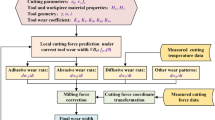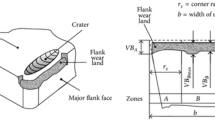Abstract
In precision hard turning, tool flank wear is one of the major factors contributing to the geometric error and thermal damage in a machined workpiece. Tool wear not only directly reduces the part geometry accuracy but also increases the cutting forces drastically. The change in cutting forces causes instability in the tool motion, and in turn, more inaccuracy. There are demands for reliably monitoring the progress of tool wear during a machining process to provide information for both correction of geometric errors and to guarantee the surface integrity of the workpiece. A new method for tool wear monitoring in precision hard turning is presented in this paper. The flank wear of a CBN tool is monitored by feature parameters extracted from the measured passive force, by the use of a force dynamometer. The feature parameters include the passive force level, the frequency energy and the accumulated cutting time. An ANN model was used to integrate these feature parameters in order to obtain more reliable and robust flank wear monitoring. Finally, the results from validation tests indicate that the developed monitoring system is robust and consistent for tool wear monitoring in precision hard turning.







Similar content being viewed by others
References
Tonshoff HK, Worker HG, Brandt D (1994) Tribological aspects of hard turning with ceramic tools. J Soc Tribol Lubric Engin 51(2):163–168
Konig W, Klinger M, Link R (1990) Machining hard materials with geometrically defined cutting edges field of applications and limitations. Annals CIRP 39(1):61–64
Fleming MA, Sweeney C, Valentine TJ, Simpkin R (1998) PCBN hard turning and workpiece surface integrity. 98(4):128–133
König W, Berktold A, and Koch KF (1993) Turning versus grinding: a comparison of surface integrity aspects and attainable accuracies. Annals of CIRP 42(1):39–43
Chou Y, Barash MM, Evans C (1995) Finish performance and wear mechanism of cubic boron nitride tools in the turning of hardened 52100 steels. In: Proceedings of the Ceramic Industry Manufacturing Conference and Exposition, Pittsburgh, PA, 11–13 October 1995
Chou YK, Evans CJ (1997) Tool wear mechanism in continuous cutting of hardened steels. Wear 212(1):59–65
Schmidt J (1999) Mechanische und thermische wirkungen beim drehen gehärteter stähle. Dissertation, University of Hannover
Acknowledgements
The authors wish to express sincere gratitude to Mr. J. Hogberg from Ovako Steel AB for his great help during the machining test. The authors would also like to thank the European Community for their support of this project.
Author information
Authors and Affiliations
Corresponding author
Rights and permissions
About this article
Cite this article
Zhou, J.M., Andersson, M. & Stahl, J.E. The monitoring of flank wear on the CBN tool in the hard turning process. Int J Adv Manuf Technol 22, 697–702 (2003). https://doi.org/10.1007/s00170-003-1569-2
Received:
Accepted:
Published:
Issue Date:
DOI: https://doi.org/10.1007/s00170-003-1569-2




